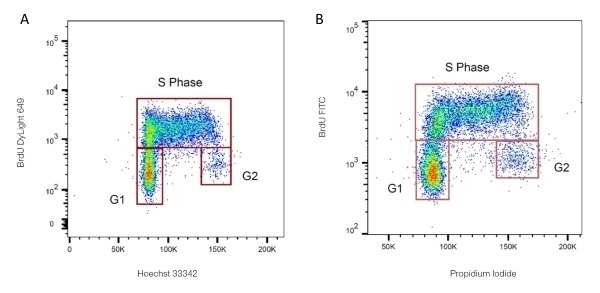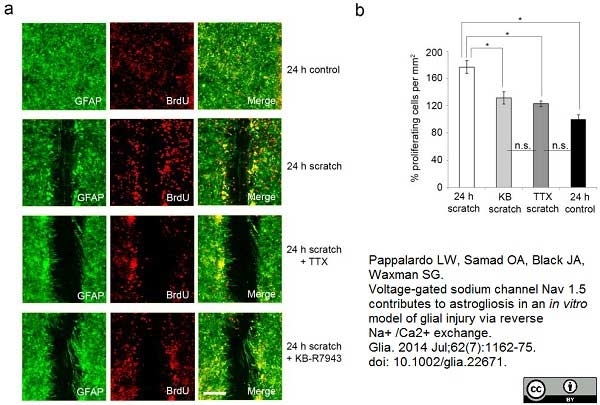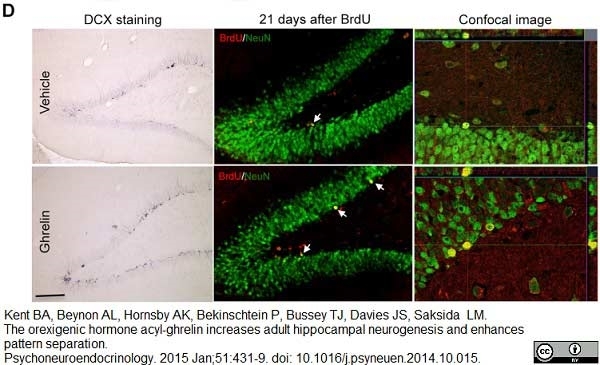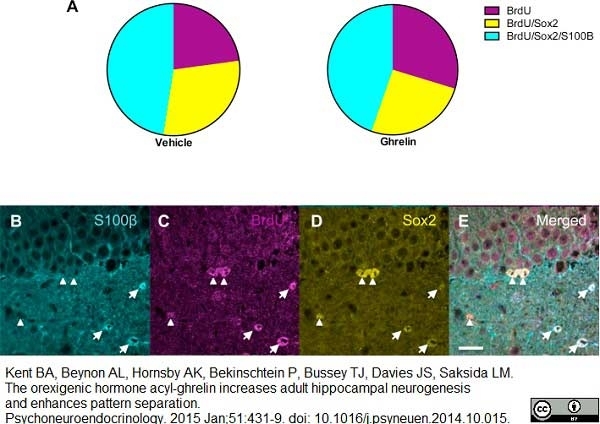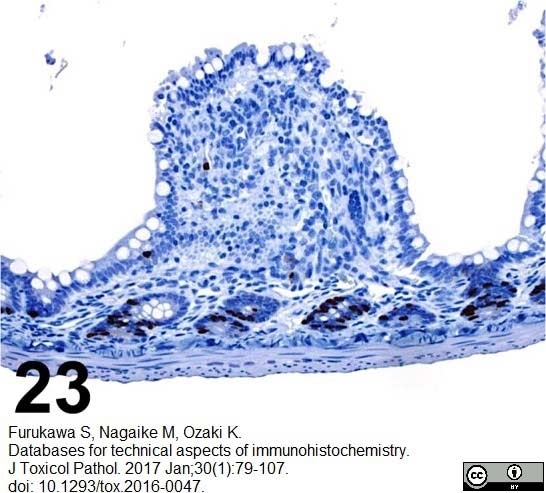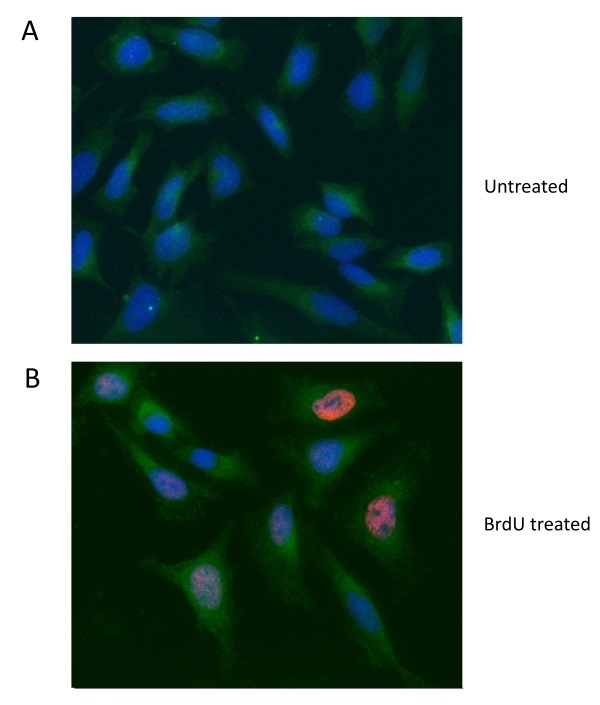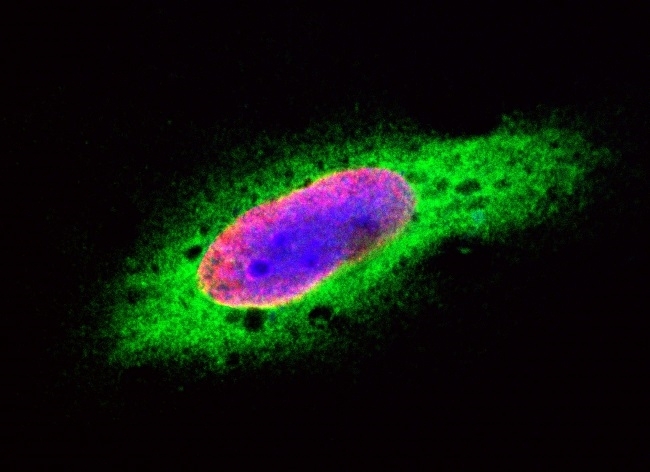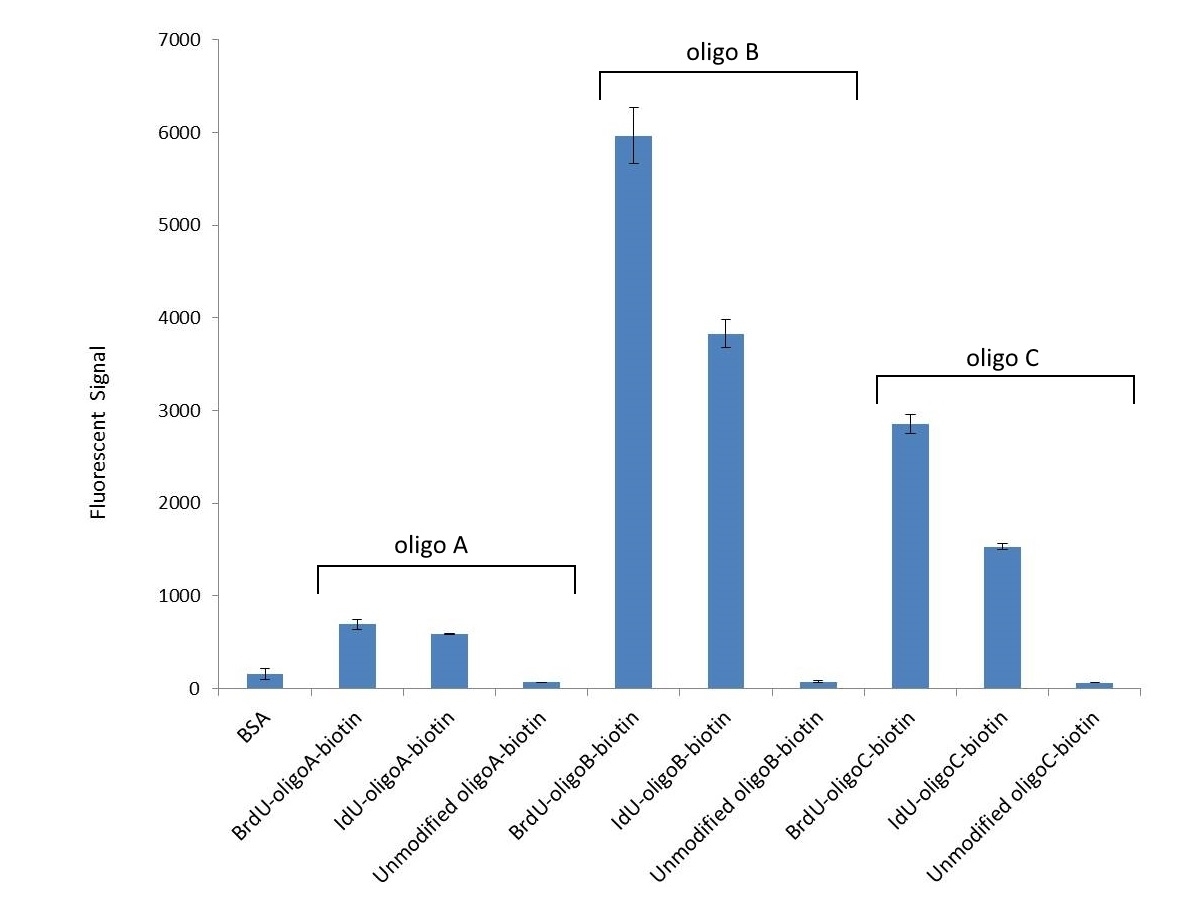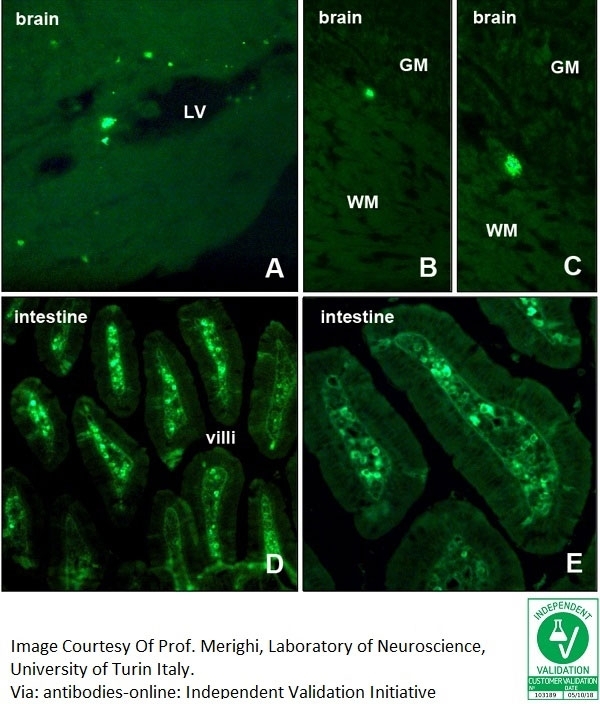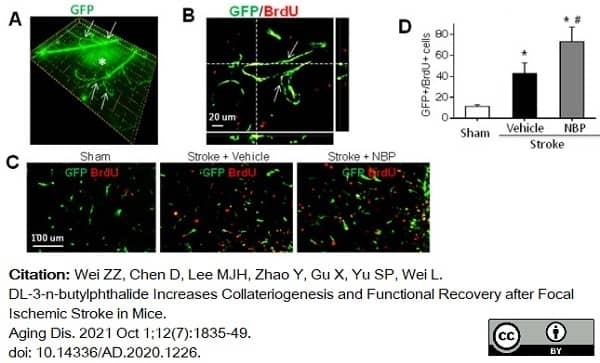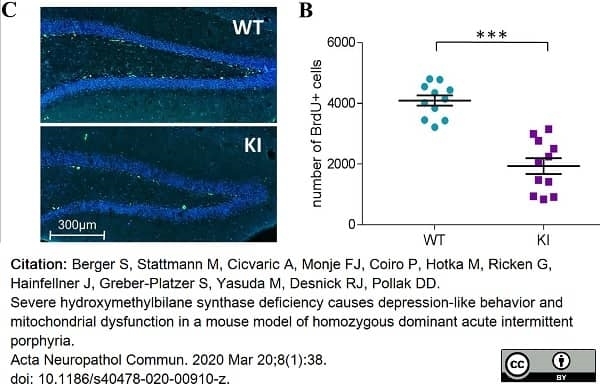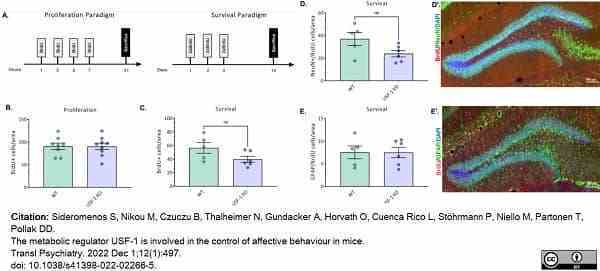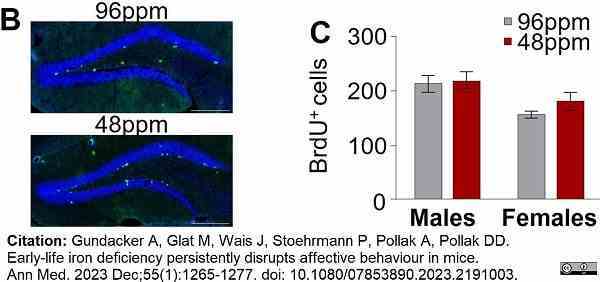BrdU antibody | Bu20a













Mouse anti BrdU
- Product Type
- Monoclonal Antibody
- Clone
- Bu20a
- Isotype
- IgG1
- Specificity
- BrdU
| Mouse anti BrdU antibody, clone Bu20a recognizes bromodeoxyuridine (known as BrdU or BrdUrd). BrdU is a synthetic thymidine analog, which is incorporated to new DNA during replication instead of thymidine. BrdU can therefore be used to identify newly synthesized DNA. Mouse anti BrdU antibody, clone Bu20a, recognizes BrdU and other thymidine analogs; 5′-chloro-2′-deoxyuridine (CldU), 5′-iodo-2′-deoxyuridine (IdU) and 2′-deoxy-5-ethynyluridine (EdU), but only shows minimal reactivity with thymidine itself (Aten et al. 1992, Liboska et al. 2012, Magaud et al. 1989). Antibody detection of incorporated BrdU in cellular DNA is extensively referenced as an accurate method to monitor cell proliferation in vivo and in vitro. In cell proliferation assays BrdU staining is coupled with the use of a dye that binds total DNA such as propidium iodide (PI). BrdU can be administered diluted in the culture medium or, in vivo via intraperitoneal injection, subcutaneous osmotic pump implants (Tesfaiqzi et al. 2004) or in drinking water (Moser et al. 2004). BrdU can be used as a thymidine analog in a wide range of organisms ranging from mammalian cells, through reptiles and amphibians to invertebrate species and plants. Mouse anti BrdU antibody, clone Bu20a, is suitable for detecting incorporated BrdU in a wide variety of cell types and is suitable for use on tissue sections in double-labeling techniques (Makarev and Gorivodsky 2014). |
- Target Species
- Chemical
- Product Form
- Purified IgG - liquid
- Preparation
- MCA2483T: Purified IgG prepared by affinity chromatography on Protein G from tissue culture supernatant
- MCA2483GA, MCA2483: Purified IgG prepared by affinity chromatography on Protein A from tissue culture supernatant
- Buffer Solution
- Phosphate buffered saline
- Preservative Stabilisers
0.09% Sodium Azide (NaN3) - Carrier Free
- Yes
- Immunogen
- Bromodeoxyuridine conjugated to BSA
- Approx. Protein Concentrations
- IgG concentration 1.0 mg/ml
- Fusion Partners
- Spleen cells from immunized Balb/c mice were fused with cells of the NS1 myeloma cell line
- Regulatory
- For research purposes only
- Guarantee
- 12 months from date of despatch
Avoid repeated freezing and thawing as this may denature the antibody. Storage in frost-free freezers is not recommended.
| Application Name | Verified | Min Dilution | Max Dilution |
|---|---|---|---|
| Flow Cytometry 1 | 1/25 | 1/100 | |
| Immunocytochemistry 2 | 1/25 | 1/100 | |
| Immunofluorescence | |||
| Immunohistology - Frozen | |||
| Immunohistology - Paraffin |
- 1 Flow Cytometry protocols can be found at:
www.bio-rad-antibodies.com/brdu-clone-bu20a-flow-cytometry-protocol
www.bio-rad-antibodies.com/brdu-staining-cell-cycle-protocol - 2 BrdU labeling and immunostaining protocol can be found at:
www.bio-rad-antibodies.com/brdu-labeling-and-immunostaining-protocol
- Flow Cytometry
- Use 10 μl of the suggested working dilution to label 1x106 cells in 100 μl
| Description | Product Code | Applications | Pack Size | List Price | Your Price | Quantity | |
|---|---|---|---|---|---|---|---|
| Goat anti Mouse IgG (H/L):FITC (Multi Species Adsorbed) | STAR117F | F | 0.5 mg |
|
Log in | ||
| List Price | Your Price | ||||||
|
|
Log in | ||||||
| Description | Goat anti Mouse IgG (H/L):FITC (Multi Species Adsorbed) | ||||||
| Rabbit F(ab')2 anti Mouse IgG:RPE | STAR12A | F | 1 ml |
|
Log in | ||
| List Price | Your Price | ||||||
|
|
Log in | ||||||
| Description | Rabbit F(ab')2 anti Mouse IgG:RPE | ||||||
| Rabbit F(ab')2 anti Mouse IgG:HRP (Human Adsorbed) | STAR13B | C E P RE WB | 1 mg |
|
Log in | ||
| List Price | Your Price | ||||||
|
|
Log in | ||||||
| Description | Rabbit F(ab')2 anti Mouse IgG:HRP (Human Adsorbed) | ||||||
| Rabbit F(ab')2 anti Mouse IgG:FITC | STAR9B | F | 1 mg |
|
Log in | ||
| List Price | Your Price | ||||||
|
|
Log in | ||||||
| Description | Rabbit F(ab')2 anti Mouse IgG:FITC | ||||||
| Description | Product Code | Applications | Pack Size | List Price | Your Price | Quantity | |
|---|---|---|---|---|---|---|---|
| Mouse IgG1 Negative Control | MCA928 | F | 100 Tests |
|
Log in | ||
| List Price | Your Price | ||||||
|
|
Log in | ||||||
| Description | Mouse IgG1 Negative Control | ||||||
Source Reference
-
Magaud, J.P. et al. (1989) Double immunocytochemical labeling of cell and tissue samples with monoclonal anti-bromodeoxyuridine.
J Histochem Cytochem. 37 (10): 1517-27.
References for BrdU antibody
-
Xie, L.L. et al. (2009) Aquaporin 4 knockout resists negative regulation of neural cell proliferation by cocaine in mouse hippocampus.
Int J Neuropsychopharmacol. 12 (6): 843-50. -
Wohl, S.G. et al. (2009) Optic nerve lesion increases cell proliferation and nestin expression in the adult mouse eye in vivo.
Exp Neurol. 219 (1): 175-86. -
Innis, S.M. et al. (2010) Perinatal lipid nutrition alters early intestinal development and programs the response to experimental colitis in young adult rats.
Am J Physiol Gastrointest Liver Physiol. 299 (6): G1376-85. -
Caronia, G. et al. (2010) Bone morphogenetic protein signaling in the developing telencephalon controls formation of the hippocampal dentate gyrus and modifies fear-related behavior.
J Neurosci. 30: 6291-301. -
Miller, C. et al. (2011) The interplay between SUCLA2, SUCLG2, and mitochondrial DNA depletion.
Biochim Biophys Acta. 1812 (5): 625-9. -
Sato, Y. et al. (2013) Grafting of neural stem and progenitor cells to the hippocampus of young, irradiated mice causes gliosis and disrupts the granule cell layer.
Cell Death Dis. 4: e591. -
Pappalardo, L.W. et al. (2014) Voltage-gated sodium channel Nav 1.5 contributes to astrogliosis in an in vitro model of glial injury via reverse Na+ /Ca2+ exchange.
Glia. 62 (7): 1162-75. -
Kent BA et al. (2015) The orexigenic hormone acyl-ghrelin increases adult hippocampal neurogenesis and enhances pattern separation.
Psychoneuroendocrinology. 51: 431-9.
View The Latest Product References
-
Laitman, B.M. et al. (2016) The Transcriptional Activator Krüppel-like Factor-6 Is Required for CNS Myelination.
PLoS Biol. 14 (5): e1002467. -
Li, Q. et al. (2017) Induced Neural Activity Promotes an Oligodendroglia Regenerative Response in the Injured Spinal Cord and Improves Motor Function after Spinal Cord Injury.
J Neurotrauma. 34 (24): 3351-61. -
Kim, H.N. et al. (2017) Comparative analysis of the beneficial effects of treadmill training and electroacupuncture in a rat model of neonatal hypoxia-ischemia.
Int J Mol Med. 39 (6): 1393-402. -
Furukawa, S. et al. (2017) Databases for technical aspects of immunohistochemistry.
J Toxicol Pathol. 30 (1): 79-107. -
Zhang, J. et al. (2018) The mechanisms underlying olfactory deficits in apolipoprotein E-deficient mice: focus on olfactory epithelium and olfactory bulb.
Neurobiol Aging. 62: 20-33. -
Berger, S. et al. (2020) Severe hydroxymethylbilane synthase deficiency causes depression-like behavior and mitochondrial dysfunction in a mouse model of homozygous dominant acute intermittent porphyria.
Acta Neuropathol Commun. 8 (1): 38. -
Wei, Z.Z. et al. (2021) DL-3-n-butylphthalide Increases Collateriogenesis and Functional Recovery after Focal Ischemic Stroke in Mice.
Aging Dis. 12 (7): 1835-49. -
Lee, H.J. et al. (2022) Effects of electroacupuncture on the functionality of NG2-expressing cells in perilesional brain tissue of mice following ischemic stroke
Neural Regeneration Research. 17 (7): 1556. -
Sideromenos, S. et al. (2022) The metabolic regulator USF-1 is involved in the control of affective behaviour in mice.
Transl Psychiatry. 12 (1): 497. -
Gundacker, A. et al. (2023) Early-life iron deficiency persistently disrupts affective behaviour in mice.
Ann Med. 55 (1): 1265-77.
- Synonyms
- 5-BROMODEOXYURIDINE
- RRID
- AB_1102864
Please Note: All Products are "FOR RESEARCH PURPOSES ONLY"
View all Anti-Chemical ProductsAlways be the first to know.
When we launch new products and resources to help you achieve more in the lab.
Yes, sign me up